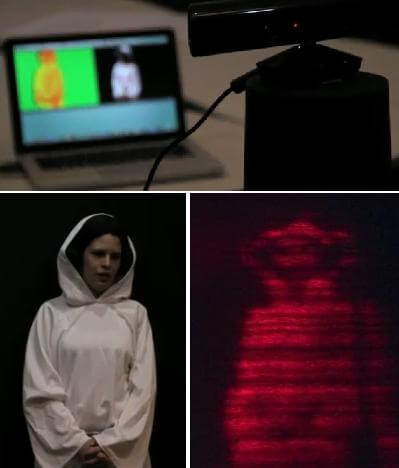
A note to researchers out there: when you develop your amazing technology, try not to compare it to things we’ve already seen in movies that look way better. Michael Bove and his team at MIT’s Media Lab have developed streaming holographic video with simple components to mimic the advanced technology seen in Star Wars. An Xbox Kinect sensor ties into an ordinary laptop to collect 3D data that can be transmitted to a PC where graphic cards convert it into a holographic image. The display is the only hardware you couldn’t buy off the shelf. As cool as live streaming holographic video may sound, Bove’s actual demonstration isn’t that awesome-looking. It’s only 15 frames per second, with really crappy resolution. Still, you have to get excited when you see MIT’s version of Princess Leia ask Obi Wan Kenobi for help using a real world hologram. Check it out in the videos below. You know what gives me hope? That Bove and his team threw this demonstration together in just a few weeks. It could get much much better very very soon.
Bove presented his Kinect-enabled streaming hologram video at SPIE 2011 in San Francisco last week. It may not have looked as good as the original version on Star Wars, but it was still impressive. As Bove told MIT News, they’ve actually improved upon the idea: “Princess Leia wasn’t being transmitted in real time. She was stored.” The MIT group was able to transmit their Leia to SPIE in real time. That speaks to the possibility that such a setup could one day form the basis for holographic TV.
To make that happen, however, Bove is going to have to speed up the frame rate considerably. Standard TV is at 30 fps, film at 24 fps. Encouragingly, the MIT team already increased the frame rate from 7 to 15 in just a week. They didn’t even have the Kinect device until late December (SPIE was on the 23rd of January). There’s a great chance that the Kinect motion-capture system and image processing could be improved quite quickly. That’s going to lead to much smoother holograms than what they’ve been able to produce so far. To get an idea of what the 15 fps looks like, check out this brief test video:
Unfortunately, it may be the display which either destroys or exalts MIT’s attempts at easy holographic video. Bove’s team is using a unique projection setup which has its roots in technology MIT’s Stephen Benton first started developing in the 1980s. It uses parallax to give the viewer a true 3D perspective. As you move around the display volume you see a new angle of the image depending on your position. That’s really great, and something you simply don’t get in 3D movies or TV. Yet that system is also bulky, and likely many years from a marketable product. MIT’s motion capture for the hologram is a really high speed hack while the display is like pouring molasses: sweet, but slow to finish.
Here’s a better demonstration of what the Benton-derived holographic display looks like over a range of viewing angles:
Maybe the best bet would be to keep Bove’s input hack, and simply find a different display technology. We’ve already seen one from Zebra Imaging. In fact, Zebra commented to MIT News that “by taking a video game and using it as an input device, [Bove] shows that [holographic video] is a hop, skip and a jump away from reality.” If a Kinect hack got us amazingly cheap 3D capture in just a few weeks, maybe a Bove-based add on to existing display tech could get us holographic TV in a few months. Not sure if that will happen, but it’s definitely A New Hope.
[image credits: Melanie Gonick (screen capture), James D Barabas,]
[source: MIT News Office, Holovideo Notes (MIT/Barabas)]


